Yujun Zhou
Beyond Single-Value Metrics: Evaluating and Enhancing LLM Unlearning with Cognitive Diagnosis
Feb 19, 2025Abstract:Due to the widespread use of LLMs and the rising critical ethical and safety concerns, LLM unlearning methods have been developed to remove harmful knowledge and undesirable capabilities. In this context, evaluations are mostly based on single-value metrics such as QA accuracy. However, these metrics often fail to capture the nuanced retention of harmful knowledge components, making it difficult to assess the true effectiveness of unlearning. To address this issue, we propose UNCD (UNlearning evaluation via Cognitive Diagnosis), a novel framework that leverages Cognitive Diagnosis Modeling for fine-grained evaluation of LLM unlearning. Our dedicated benchmark, UNCD-Cyber, provides a detailed assessment of the removal of dangerous capabilities. Moreover, we introduce UNCD-Agent, which refines unlearning by diagnosing knowledge remnants and generating targeted unlearning data. Extensive experiments across eight unlearning methods and two base models demonstrate that UNCD not only enhances evaluation but also effectively facilitates the removal of harmful LLM abilities.
Social Science Meets LLMs: How Reliable Are Large Language Models in Social Simulations?
Oct 30, 2024Abstract:Large Language Models (LLMs) are increasingly employed for simulations, enabling applications in role-playing agents and Computational Social Science (CSS). However, the reliability of these simulations is under-explored, which raises concerns about the trustworthiness of LLMs in these applications. In this paper, we aim to answer ``How reliable is LLM-based simulation?'' To address this, we introduce TrustSim, an evaluation dataset covering 10 CSS-related topics, to systematically investigate the reliability of the LLM simulation. We conducted experiments on 14 LLMs and found that inconsistencies persist in the LLM-based simulated roles. In addition, the consistency level of LLMs does not strongly correlate with their general performance. To enhance the reliability of LLMs in simulation, we proposed Adaptive Learning Rate Based ORPO (AdaORPO), a reinforcement learning-based algorithm to improve the reliability in simulation across 7 LLMs. Our research provides a foundation for future studies to explore more robust and trustworthy LLM-based simulations.
LabSafety Bench: Benchmarking LLMs on Safety Issues in Scientific Labs
Oct 18, 2024



Abstract:Laboratory accidents pose significant risks to human life and property, underscoring the importance of robust safety protocols. Despite advancements in safety training, laboratory personnel may still unknowingly engage in unsafe practices. With the increasing reliance on large language models (LLMs) for guidance in various fields, including laboratory settings, there is a growing concern about their reliability in critical safety-related decision-making. Unlike trained human researchers, LLMs lack formal lab safety education, raising questions about their ability to provide safe and accurate guidance. Existing research on LLM trustworthiness primarily focuses on issues such as ethical compliance, truthfulness, and fairness but fails to fully cover safety-critical real-world applications, like lab safety. To address this gap, we propose the Laboratory Safety Benchmark (LabSafety Bench), a comprehensive evaluation framework based on a new taxonomy aligned with Occupational Safety and Health Administration (OSHA) protocols. This benchmark includes 765 multiple-choice questions verified by human experts, assessing LLMs and vision language models (VLMs) performance in lab safety contexts. Our evaluations demonstrate that while GPT-4o outperforms human participants, it is still prone to critical errors, highlighting the risks of relying on LLMs in safety-critical environments. Our findings emphasize the need for specialized benchmarks to accurately assess the trustworthiness of LLMs in real-world safety applications.
Defending Jailbreak Prompts via In-Context Adversarial Game
Feb 20, 2024
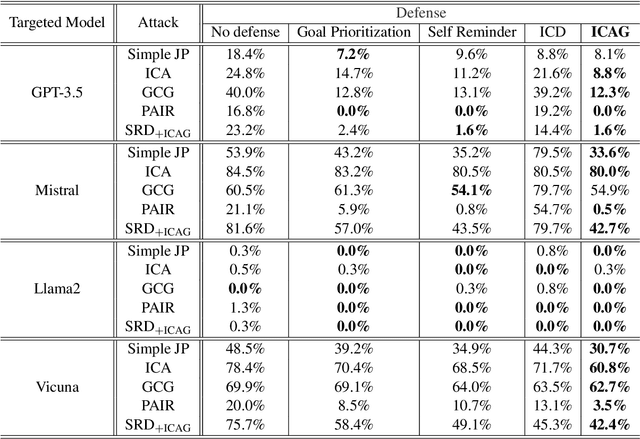

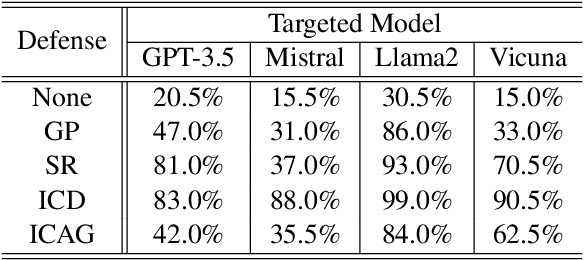
Abstract:Large Language Models (LLMs) demonstrate remarkable capabilities across diverse applications. However, concerns regarding their security, particularly the vulnerability to jailbreak attacks, persist. Drawing inspiration from adversarial training in deep learning and LLM agent learning processes, we introduce the In-Context Adversarial Game (ICAG) for defending against jailbreaks without the need for fine-tuning. ICAG leverages agent learning to conduct an adversarial game, aiming to dynamically extend knowledge to defend against jailbreaks. Unlike traditional methods that rely on static datasets, ICAG employs an iterative process to enhance both the defense and attack agents. This continuous improvement process strengthens defenses against newly generated jailbreak prompts. Our empirical studies affirm ICAG's efficacy, where LLMs safeguarded by ICAG exhibit significantly reduced jailbreak success rates across various attack scenarios. Moreover, ICAG demonstrates remarkable transferability to other LLMs, indicating its potential as a versatile defense mechanism.
SceMQA: A Scientific College Entrance Level Multimodal Question Answering Benchmark
Feb 06, 2024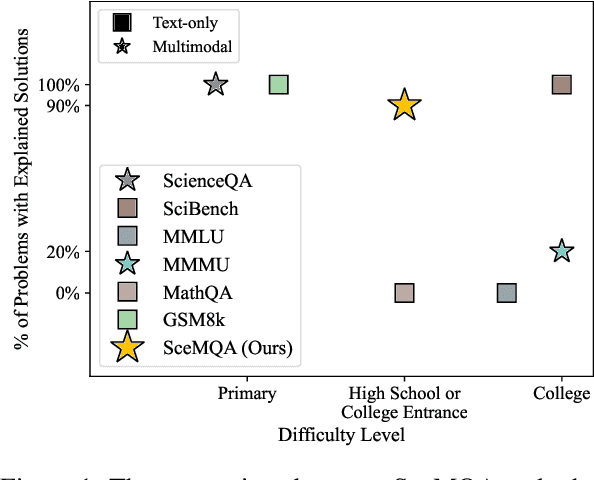

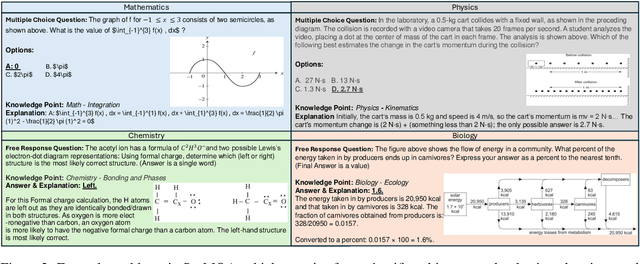
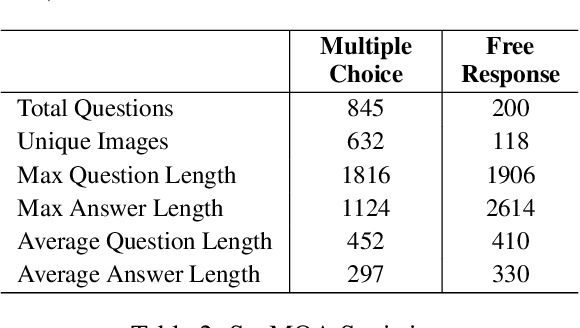
Abstract:The paper introduces SceMQA, a novel benchmark for scientific multimodal question answering at the college entrance level. It addresses a critical educational phase often overlooked in existing benchmarks, spanning high school to pre-college levels. SceMQA focuses on core science subjects including Mathematics, Physics, Chemistry, and Biology. It features a blend of multiple-choice and free-response formats, ensuring a comprehensive evaluation of AI models' abilities. Additionally, our benchmark provides specific knowledge points for each problem and detailed explanations for each answer. SceMQA also uniquely presents problems with identical contexts but varied questions to facilitate a more thorough and accurate assessment of reasoning capabilities. In the experiment, we evaluate both open-source and close-source state-of-the-art Multimodal Large Language Models (MLLMs), across various experimental settings. The results show that further research and development are needed in developing more capable MLLM, as highlighted by only 50% to 60% accuracy achieved by the strongest models. Our benchmark and analysis will be available at https://scemqa.github.io/
An Improved Grey Wolf Optimization Algorithm for Heart Disease Prediction
Jan 22, 2024Abstract:This paper presents a unique solution to challenges in medical image processing by incorporating an adaptive curve grey wolf optimization (ACGWO) algorithm into neural network backpropagation. Neural networks show potential in medical data but suffer from issues like overfitting and lack of interpretability due to imbalanced and scarce data. Traditional Gray Wolf Optimization (GWO) also has its drawbacks, such as a lack of population diversity and premature convergence. This paper addresses these problems by introducing an adaptive algorithm, enhancing the standard GWO with a sigmoid function. This algorithm was extensively compared to four leading algorithms using six well-known test functions, outperforming them effectively. Moreover, by utilizing the ACGWO, we increase the robustness and generalization of the neural network, resulting in more interpretable predictions. Applied to the publicly accessible Cleveland Heart Disease dataset, our technique surpasses ten other methods, achieving 86.8% accuracy, indicating its potential for efficient heart disease prediction in the clinical setting.
Towards Efficient and Domain-Agnostic Evasion Attack with High-dimensional Categorical Inputs
Dec 13, 2022Abstract:Our work targets at searching feasible adversarial perturbation to attack a classifier with high-dimensional categorical inputs in a domain-agnostic setting. This is intrinsically an NP-hard knapsack problem where the exploration space becomes explosively larger as the feature dimension increases. Without the help of domain knowledge, solving this problem via heuristic method, such as Branch-and-Bound, suffers from exponential complexity, yet can bring arbitrarily bad attack results. We address the challenge via the lens of multi-armed bandit based combinatorial search. Our proposed method, namely FEAT, treats modifying each categorical feature as pulling an arm in multi-armed bandit programming. Our objective is to achieve highly efficient and effective attack using an Orthogonal Matching Pursuit (OMP)-enhanced Upper Confidence Bound (UCB) exploration strategy. Our theoretical analysis bounding the regret gap of FEAT guarantees its practical attack performance. In empirical analysis, we compare FEAT with other state-of-the-art domain-agnostic attack methods over various real-world categorical data sets of different applications. Substantial experimental observations confirm the expected efficiency and attack effectiveness of FEAT applied in different application scenarios. Our work further hints the applicability of FEAT for assessing the adversarial vulnerability of classification systems with high-dimensional categorical inputs.
 Add to Chrome
Add to Chrome Add to Firefox
Add to Firefox Add to Edge
Add to Edge